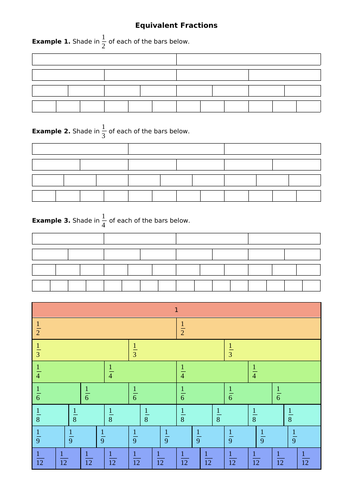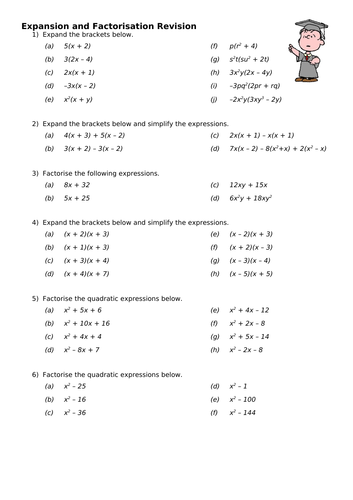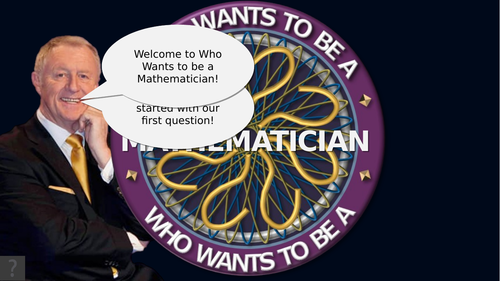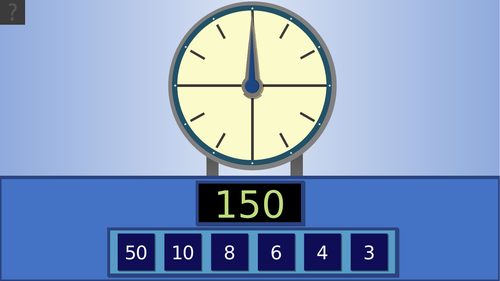79Uploads
58k+Views
23k+Downloads
Math

Pirate Game, 15 Different Pages
The famous pirate game. Perfect for end-of-term activity.
This slight variation uses a random name generator alongside it to choose who gets hit by the uncontrollable bomb (the students love this aspect).
Instructions for play are on the notes of the first slide. This slide has the grid on which I use to cross out grid references during the game.
All images and text has “no background” so the sheets can be printed on any color sheet and still look good.

Countdown Game Template
This is a template for the numbers and letters round of the game Countdown.
Both slides have animated entry for the letters/numbers.
Both slides have animated Countdown clock.
Both slides have Countdown clock “music” which plays with the animation.

Colouring Bars for Equivalent Fractions
A nice simple worksheet for students to use for shading in bars to see fractions which are equivalent. Perfect for primary and secondary mathematics lessons.
This activity is especially nice for the more visual learners, and those who find it more difficult to conceptualize mathematics.
This resource includes a rainbow-colored “fraction wall” for students to refer to. This wall is helpfully the same width as the bars for the examples and the questions.
All parts of the resource are easily editable. It had a dyslexic-friendly font and can be printed on any color paper without loss of aesthetic.
This is also a nice time to introduce to the students the idea of the “part to whole” relationship that fractions indicate.
As always, if you do choose to download this resource, thank you, and please leave feedback for any improvements I could make to it.

Matchstick Puzzles
These are really fun starter activities for students, especially those who find maths difficult and struggle to enjoy it. This activity is perfect for the run up to the holidays and can be used with any class, primary or secondary. Several of the puzzles also have multiple solutions, so this isn’t just a “who can finish first activity”.
This presentation contains over 3 0 puzzles of varying difficulty, each one with its own animated solution.
If you do download this presentation, please leave feedback on how I can improve them. Or if you would like me to increase the number of puzzles, feel free to post a link to the puzzle you’d like me to put in.

Who Wants to be a [Subject]
Who Wants to be a: Mathematician, Biologist, Physicist, Chemist, Musician, Computer Genius etc.
A template which is fully animated with authentic images and designs. Editable logos.
A “homemade” logo, option shapes, money ladder, etc. This presentation also includes the theme song for thirty second on the title page and the “correct answer” noise with the authentic green flash for a correct answer. Animations are triggered by selecting the options.
Simply insert the questions and answer (being careful to ensure the “correct” option goes into the correct place).
The order of correct places is:
A, C, D, C, D, A, B, B, A, D, B, C, D, A, C.
This is a great tool for assess children’s understanding and can be used alongside diagnostic questions.
It is also great as an end-of-term activity or as part of a fun quiz.
Further instructions are in the notes of Slide 1.
A reminder of which places is the “correct” one is on each of the slides.
Please leave reviews on how I can improve this resource.
Also, feel free to take a look at the other resources I have uploaded.

Template for Function Machines
Here is a collection of 8 function machine templates.
All machines are customizable. In particular, the input, operations, and outputs are all editable.
Machines include “glass” to be able to “see into the machine”.
1st - single function, a goes in, 3 x a comes out. Good for questioning about understanding of what function machines are.
2nd - single function and its inverse. good to discuss what inverse of multiplication is etc.
3rd - Solving one-step equation. Template is for x 3 but can be anything. This slide does not include checking solution.
4th - solving one-step equation. This slide includes checking solution by putting it through the first operations.
5th - two-step function. Involving two function machines. Useful for discussing the importance of the order of operations.
6th - two-step operations with inverses. Again, useful for talking about the importance of the order of operations. This is a good visual and the term will go through the machines in the reverse order.
7th - Solving two-step equation. This slide does not include checking solution.
8th - Solving two-step equation. This slide does include checking solution.

Factorisation/Simplification Revision
A collection of forty questions with increasing difficulty.
All questions have answers provided on the second page.
Expanding brackets an simplifying involving positives, negatives, squares, and higher powers.
Expanding two separate brackets and simplifying the resulting expression.
Factorizing into a single bracket.
Expanding double brackets to form quadratic expressions.
Factorizing quadratics into double brackets.
Factorizing “difference of two squares” into a single, squared, bracket.
If you choose to download, thank you, and please leave feedback on any possible improvements I can make to this resource.

Preview Introduction to Algebra
This is a free pdf view of the lesson available here:
https://www.tes.com/teaching-resource/introduction-to-algebra-12035879
This pdf is a full view of the lesson mentioned above. The idea is that you get a full idea of the structure and look of the lesson before making a fully-informed decision about whether or not to purchase the PowerPoint lesson.
This pdf does not include the automatically udating date in the top right corner, nor does it include the animations present on the PowerPoint.

Pirate Game Variation
This is a simple variation on the classic Pirate Game (see here).
This version has twelve different pages with a different pirate on each. Each pirate has a single extra item. The first pirate has an extra “steal”, the second has an extra “kill” and so on.
Ideally, this game is to be played in teams. I have tried it with individual students as their own “team”, and generally it takes a very long time to get through parts of the game.

Who Wants to be a Mathematician (FDP)
collection of fifteen questions with fully animated solutions in the form of Who Wants to be a Millionaire.
This is perfect for the end of a lesson, a recap, or an end-of-topic activity.
Topics are:
Decimals to fractions
Fractions to decimals
True or False questions
Largest/smallest decimals and fractions
Fractions of an amount.
The template for this presentation, so you can create your own if you choose, can be found here.
I have a few other similar resources, so please check out my others!
If you do choose to download my resource(s), thank you, and please leave feedback on how I can improve.

Countdown Basic Geometry Vocabulary
Here is a collection of eighty-six words related to Basic Geometry. Each slide is accompanied with an animation of the Countdown Clock, and the tune to accompany the timer.
All words are between 3 and 9 letters long. All words are in size, then alphabetical order.
It includes: Angles, Height, Volume, Pyramid, and Perimeter.
These slides are perfect to use as start activities or plenaries for key words on the topic.
If you decide to download, thank you, and please leave a review along with any suggestions on how I could improve the resource.
I also have a number of other collections of vocabulary for topics including Co-ordinate Geometry, Algebra, Number, and Reasoning.

Countdown Algebra Vocabulary
Here is a collection of fifty-six words related to Co-ordinate Geometry. Each slide is accompanied with an animation of the Countdown Clock, and the tune to accompany the timer.
All words are between 3 and 9 letters long. All words are in size, then alphabetical order.
It includes: Domain, Inverse, Binomial, Exponent, and Quadratic.
These slides are perfect to use as start activities or plenaries for key words on the topic.
If you decide to download, thank you, and please leave a review along with any suggestions on how I could improve the resource.
I also have a number of other collections of vocabulary for topics including Statistics and Probability, Reasoning, Number, and Basic Geometry.

Countdown Stats and Probability Vocab
Here is a collection of seventy-five words related to Statistics and Probability. Each slide is accompanied with an animation of the Countdown Clock, and the tune to accompany the timer.
All words are between 3 and 9 letters long. All words are in size, then alphabetical order.
It includes: Constant, Mean, Deviation, Probable, and Mutually.
These slides are perfect to use as start activities or plenaries for key words on the topic.
If you decide to download, thank you, and please leave a review along with any suggestions on how I could improve the resource.
I also have a number of other collections of vocabulary for topics including Co-ordinate Geometry, Algebra, Number, and Basic Geometry.

Countdown Reasoning Vocabulary
Here is a collection of forty-three words related to Co-ordinate Geometry. Each slide is accompanied with an animation of the Countdown Clock, and the tune to accompany the timer.
All words are between 3 and 9 letters long. All words are in size, then alphabetical order.
It includes: Compare, Inverse, Absolute, Classify, and Reasoning.
These slides are perfect to use as start activities or plenaries for key words on the topic.
If you decide to download, thank you, and please leave a review along with any suggestions on how I could improve the resource.
I also have a number of other collections of vocabulary for topics including Statistics and Probability, Algebra, Number, and Basic Geometry.

Countdown Co-ord Geometry Vocabulary
Here is a collection of sixty-nine words related to Co-ordinate Geometry. Each slide is accompanied with an animation of the Countdown Clock, and the tune to accompany the timer.
All words are between 3 and 9 letters long. All words are in size, then alphabetical order.
It includes: Symmetry, Collinear, Intercept, Parallel, and Plane.
These slides are perfect to use as start activities or plenaries for key words on the topic.
If you decide to download, thank you, and please leave a review along with any suggestions on how I could improve the resource.
I also have a number of other collections of vocabulary for topics including Statistics and Probability, Algebra, Number, and Basic Geometry.

50 Home School Countdown Numbers Game
Perfect for home school maths fun!
Pease remember to rate and review
A selection of fifty of the numbers game from Countdown.
Each slide has music along with the animation.
Answers are provided with each of the examples - although there are other ways to get the answer as well.
Every tenth example has the best possible solution 1 away from the target.
Bundle

Countdown Game for Maths Vocabulary
A collection of over 400 maths-related words all with the animation and theme music of Countdown. This is a really fun and easy way to encourage students to play along and take notice of key words for different topics.

Algebra 03/31 Forming Expressions
This lesson titled ‘Forming Expressions’ is fully differentiated, and uses whiteboard questions as a scaffolding and Assessment for Learning method.
These whiteboard questions are also particularly useful for reducing students’ maths anxiety by providing them with multiple answer they can choose from. All of the whiteboard questions have diagnostic-style wrong answers, obtained from common misconceptions
The title of the lesson is throughout the PowerPoint. This provides consistency throughout, allows students to catch up if they missed it, and takes late-comers into consideration. The date is also throughout the PowerPoint and updates automatically. This is done so that the students know exactly where it is each lesson, and to make it easier on the class teacher.
A dyslexic-friendly font (Verdana) is used throughout the PowerPoint and any worksheets.
Worksheets are embedded in the PowerPoint on the slides to which they relate.
Animated answers to all questions are provided where possible.
The learning objectives are designed to be as short sentences as possible to allow students to read them and write them down (if necessary) as quickly as possible. They also use a mixture of simplistic and specialised words to engages students’ thinking about definitions whilst allowing them to access the meaning of the sentences. These objectives are reviewed at the end of the lesson as a self-evaluation of learning technique. Students are awarded ‘brain’ medals depending on how well they have done.
These are kept as simple as possible and broken down carefully. This is to encourage students to access the material whilst giving them the confidence by achieving something in the lesson.
B) Link sentences and expressions.
S) Construct expressions from diagrams.
G) Simplify expressions.
If you like the resource, please leave a review. If you didn’t please leave one anyway with any suggestions on how I could improve it.
Whilst this lesson is part of a larger bundle, and does link nicely with some of the other lessons, it can certainly be used independently as well.

Probability 03/13 Mutually Exclusive Events
This lesson titled ‘Mutually Exclusive Events’ is fully differentiated, and uses whiteboard questions as a scaffolding and Assessment for Learning method.
These whiteboard questions are also particularly useful for reducing students’ maths anxiety by providing them with multiple answer they can choose from. All of the whiteboard questions have diagnostic-style wrong answers, obtained from common misconceptions
The title of the lesson is throughout the PowerPoint. This provides consistency throughout, allows students to catch up if they missed it, and takes late-comers into consideration. The date is also throughout the PowerPoint and updates automatically. This is done so that the students know exactly where it is each lesson, and to make it easier on the class teacher.
A dyslexic-friendly font (Verdana) is used throughout the PowerPoint and any worksheets.
Worksheets are embedded in the PowerPoint on the slides to which they relate.
Animated answers to all questions are provided where possible.
The learning objectives are designed to be as short sentences as possible to allow students to read them and write them down (if necessary) as quickly as possible. They also use a mixture of simplistic and specialised words to engages students’ thinking about definitions whilst allowing them to access the meaning of the sentences. These objectives are reviewed at the end of the lesson as a self-evaluation of learning technique. Students are awarded ‘brain’ medals depending on how well they have done.
These are kept as simple as possible and broken down carefully. This is to encourage students to access the material whilst giving them the confidence by achieving something in the lesson.
B) List successful outcomes of an event.
S) Determine if events are mutually exclusive.
G) List mutually exclusive events.
If you like the resource, please leave a review. If you didn’t please leave one anyway with any suggestions on how I could improve it.
Whilst this lesson is part of a larger bundle, and does link nicely with some of the other lessons, it can certainly be used independently as well.

Probability 04/13 Exhaustive Events
This lesson titled ‘Exhaustive Events’ is fully differentiated, and uses whiteboard questions as a scaffolding and Assessment for Learning method.
These whiteboard questions are also particularly useful for reducing students’ maths anxiety by providing them with multiple answer they can choose from. All of the whiteboard questions have diagnostic-style wrong answers, obtained from common misconceptions
The title of the lesson is throughout the PowerPoint. This provides consistency throughout, allows students to catch up if they missed it, and takes late-comers into consideration. The date is also throughout the PowerPoint and updates automatically. This is done so that the students know exactly where it is each lesson, and to make it easier on the class teacher.
A dyslexic-friendly font (Verdana) is used throughout the PowerPoint and any worksheets.
Worksheets are embedded in the PowerPoint on the slides to which they relate.
Animated answers to all questions are provided where possible.
The learning objectives are designed to be as short sentences as possible to allow students to read them and write them down (if necessary) as quickly as possible. They also use a mixture of simplistic and specialised words to engages students’ thinking about definitions whilst allowing them to access the meaning of the sentences. These objectives are reviewed at the end of the lesson as a self-evaluation of learning technique. Students are awarded ‘brain’ medals depending on how well they have done.
These are kept as simple as possible and broken down carefully. This is to encourage students to access the material whilst giving them the confidence by achieving something in the lesson.
B) List all outcomes of an event.
S) Learn how to calculate missing probabilities of outcomes.
G) Calculate missing probabilities of outcomes.
If you like the resource, please leave a review. If you didn’t please leave one anyway with any suggestions on how I could improve it.
Whilst this lesson is part of a larger bundle, and does link nicely with some of the other lessons, it can certainly be used independently as well.





![Who Wants to be a [Subject]](https://d1e4pidl3fu268.cloudfront.net/d75c72d6-c66c-44ae-8412-18ac1783511f/ScreenShot20181201at140018.crop_675x506_0,19.preview.png)














